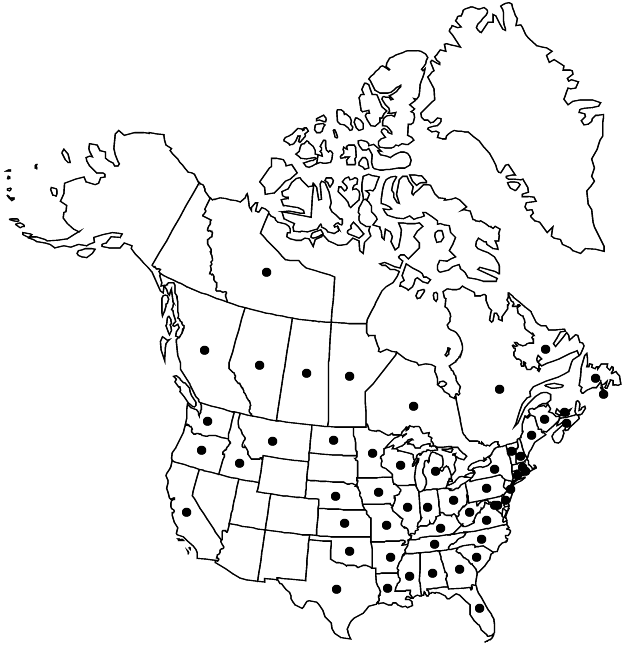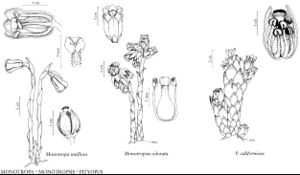Difference between pages "Pterospora" and "Monotropa uniflora"
Sp. Pl. 1: 387. 1753 ,.
FNA>Volume Importer |
FNA>Volume Importer |
||
| Line 1: | Line 1: | ||
{{Treatment/ID | {{Treatment/ID | ||
| − | |accepted_name= | + | |accepted_name=Monotropa uniflora |
| − | |accepted_authority= | + | |accepted_authority=Linnaeus |
|publications={{Treatment/Publication | |publications={{Treatment/Publication | ||
| − | |title= | + | |title=Sp. Pl. |
| − | |place=1: | + | |place=1: 387. 1753 , |
}} | }} | ||
| + | |common_names=Indian-pipe;monotrope uniflore | ||
|basionyms= | |basionyms= | ||
| − | |synonyms= | + | |synonyms={{Treatment/ID/Synonym |
| − | |hierarchy=Ericaceae;Ericaceae subfam. Monotropoideae; | + | |name=Monotropa brittonii |
| − | |hierarchy_nav=<div class="higher-taxa"><div class="higher-taxon"><small>family</small>[[Ericaceae]]</div><div class="higher-taxon"><small>subfamily</small>[[Ericaceae subfam. Monotropoideae]]</div><div class="higher-taxon"><small>genus</small>[[ | + | |authority=Small |
| − | + | }} | |
| + | |hierarchy=Ericaceae;Ericaceae subfam. Monotropoideae;Monotropa;Monotropa uniflora | ||
| + | |hierarchy_nav=<div class="higher-taxa"><div class="higher-taxon"><small>family</small>[[Ericaceae]]</div><div class="higher-taxon"><small>subfamily</small>[[Ericaceae subfam. Monotropoideae]]</div><div class="higher-taxon"><small>genus</small>[[Monotropa]]</div><div class="higher-taxon"><small>species</small>[[Monotropa uniflora]]</div></div> | ||
|volume=Volume 8 | |volume=Volume 8 | ||
| − | |mention_page= | + | |mention_page= |
| − | |treatment_page=page | + | |treatment_page=page 392 |
}}<!-- | }}<!-- | ||
| − | --><span class="statement" id="st-undefined" data-properties=""> | + | --><span class="statement" id="st-undefined" data-properties=""><b>Inflorescences </b>solitary flowers, 5–30 cm; axis white. <b>Pedicels</b> nodding at anthesis, erect in fruit. <b>Flowers</b>: sepals (3–)5(–6), similar to subtending bracts, lanceolate to oblong, 7–10 × 4–6 mm; petals (3–)5(–6), white to pinkish or reddish, obovate, 10–20 × 5–15 mm, base slightly saccate, margins entire, apex rounded or, rarely, slightly lacerate, adaxial surfaces with scattered hairs; nectary lobes 10, elongate, curved-cylindric; stamens 8–14; filaments glabrous or sparsely hairy; anthers horizontal at anthesis, transversely ellipsoid to depressed-ovoid, abaxial pair of sacs smaller; ovary 6–12 × 5–9 mm, glabrous or sparsely hairy; style 2–7 × 2–5 mm, glabrous or sparsely hairy; stigma broadly funnelform, 2–6 mm diam., not subtended by ring of crowded hairs. <b>Capsules</b> 5-segmented; segments persistent after seed dispersal, stout, 7–11 × 5–12 mm, often connected along margins by fine, pinnate, vascular strands. <b>Seeds</b> 0.5–1 mm, mostly membranously winged. <b>2n</b> = 32, 48.</span><!-- |
-->{{Treatment/Body | -->{{Treatment/Body | ||
| − | | | + | |phenology=Flowering early summer–fall. |
| − | | | + | |habitat=Moist to dry, coniferous and mixed-deciduous forests |
| − | + | |elevation=0-3000 m | |
| + | |distribution=St. Pierre and Miquelon;Alta.;B.C.;Man.;N.B.;Nfld. and Labr.;N.W.T.;N.S.;Ont.;P.E.I.;Que.;Sask.;Ala.;Ark.;Calif.;Conn.;Del.;D.C.;Fla.;Ga.;Idaho;Ill.;Ind.;Iowa;Kans.;Ky.;La.;Maine;Md.;Mass.;Mich.;Minn.;Miss.;Mo.;Mont.;Nebr.;N.H.;N.J.;N.Y.;N.C.;N.Dak.;Ohio;Okla.;Oreg.;Pa.;R.I.;S.C.;Tenn.;Tex.;Vt.;Va.;Wash.;W.Va.;Wis.;s Mexico;Central America;South America (Colombia);s;e Asia. | ||
|tables= | |tables= | ||
| − | |references= | + | |references= |
| − | |||
| − | |||
| − | |||
| − | |||
| − | |||
| − | |||
| − | |||
| − | |||
| − | |||
}}<!-- | }}<!-- | ||
| Line 38: | Line 33: | ||
-->{{#Taxon: | -->{{#Taxon: | ||
| − | name= | + | name=Monotropa uniflora |
| − | |author= | + | |author= |
| − | |authority= | + | |authority=Linnaeus |
| − | |rank= | + | |rank=species |
| − | |parent rank= | + | |parent rank=genus |
| − | |synonyms= | + | |synonyms=Monotropa brittonii |
|basionyms= | |basionyms= | ||
|family=Ericaceae | |family=Ericaceae | ||
| − | |distribution= | + | |phenology=Flowering early summer–fall. |
| − | |reference= | + | |habitat=Moist to dry, coniferous and mixed-deciduous forests |
| − | |publication title= | + | |elevation=0-3000 m |
| + | |distribution=St. Pierre and Miquelon;Alta.;B.C.;Man.;N.B.;Nfld. and Labr.;N.W.T.;N.S.;Ont.;P.E.I.;Que.;Sask.;Ala.;Ark.;Calif.;Conn.;Del.;D.C.;Fla.;Ga.;Idaho;Ill.;Ind.;Iowa;Kans.;Ky.;La.;Maine;Md.;Mass.;Mich.;Minn.;Miss.;Mo.;Mont.;Nebr.;N.H.;N.J.;N.Y.;N.C.;N.Dak.;Ohio;Okla.;Oreg.;Pa.;R.I.;S.C.;Tenn.;Tex.;Vt.;Va.;Wash.;W.Va.;Wis.;s Mexico;Central America;South America (Colombia);s;e Asia. | ||
| + | |reference=None | ||
| + | |publication title=Sp. Pl. | ||
|publication year= | |publication year= | ||
|special status= | |special status= | ||
| − | |source xml=https://jpend@bitbucket.org/aafc-mbb/fna-data-curation.git/src/8f726806613d60c220dc4493de13607dd3150896/coarse_grained_fna_xml/V8/ | + | |source xml=https://jpend@bitbucket.org/aafc-mbb/fna-data-curation.git/src/8f726806613d60c220dc4493de13607dd3150896/coarse_grained_fna_xml/V8/V8_741.xml |
|subfamily=Ericaceae subfam. Monotropoideae | |subfamily=Ericaceae subfam. Monotropoideae | ||
| − | |genus= | + | |genus=Monotropa |
| + | |species=Monotropa uniflora | ||
}}<!-- | }}<!-- | ||
| − | -->[[Category:Treatment]][[Category: | + | -->[[Category:Treatment]][[Category:Monotropa]] |
Revision as of 19:08, 18 September 2019
Inflorescences solitary flowers, 5–30 cm; axis white. Pedicels nodding at anthesis, erect in fruit. Flowers: sepals (3–)5(–6), similar to subtending bracts, lanceolate to oblong, 7–10 × 4–6 mm; petals (3–)5(–6), white to pinkish or reddish, obovate, 10–20 × 5–15 mm, base slightly saccate, margins entire, apex rounded or, rarely, slightly lacerate, adaxial surfaces with scattered hairs; nectary lobes 10, elongate, curved-cylindric; stamens 8–14; filaments glabrous or sparsely hairy; anthers horizontal at anthesis, transversely ellipsoid to depressed-ovoid, abaxial pair of sacs smaller; ovary 6–12 × 5–9 mm, glabrous or sparsely hairy; style 2–7 × 2–5 mm, glabrous or sparsely hairy; stigma broadly funnelform, 2–6 mm diam., not subtended by ring of crowded hairs. Capsules 5-segmented; segments persistent after seed dispersal, stout, 7–11 × 5–12 mm, often connected along margins by fine, pinnate, vascular strands. Seeds 0.5–1 mm, mostly membranously winged. 2n = 32, 48.
Phenology: Flowering early summer–fall.
Habitat: Moist to dry, coniferous and mixed-deciduous forests
Elevation: 0-3000 m
Distribution

St. Pierre and Miquelon, Alta., B.C., Man., N.B., Nfld. and Labr., N.W.T., N.S., Ont., P.E.I., Que., Sask., Ala., Ark., Calif., Conn., Del., D.C., Fla., Ga., Idaho, Ill., Ind., Iowa, Kans., Ky., La., Maine, Md., Mass., Mich., Minn., Miss., Mo., Mont., Nebr., N.H., N.J., N.Y., N.C., N.Dak., Ohio, Okla., Oreg., Pa., R.I., S.C., Tenn., Tex., Vt., Va., Wash., W.Va., Wis., s Mexico, Central America, South America (Colombia), s, e Asia.
Discussion
Selected References
None.
